Written by Majid Hasan, Co-Founder, ESGenie
While AI has sustainability challenges of its own to overcome—ranging from large Carbon footprint of training large AI models, to low-wage work employed to train AI models—it also offers enormous potential in solving some of the pressing sustainability challenges the world faces today, ranging from fighting climate change, preserving biodiversity, to reducing social inequalities.
The positive potential of today’s AI lies in its ability to self-learn complex relationships by combing through troves of information at a much larger scale than is humanly possible. This allows AI to:
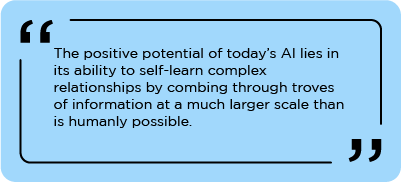
- Observe meaningful features and structures in messy data that would otherwise be hidden from the human eye, e.g. in the case of air pollution monitoring;
- Uncover non-linear relationships between variables in complex real-world systems, e.g. the relationship between geographical temperature patterns and future warming potential, that are otherwise mathematically intractable;
- Provide insights that are customized to specific details of the situations, and avoid over-generalisations, e.g. in the case of measuring air pollution at specific locations;
- Improve itself over time, and learn to do things that it was not specifically trained for—developing the so-called emergent abilities.
The spectrum of AI use-cases
Boston Consulting Group summarizes use cases for AI across the entire chain of climate action, ranging from factual measurements of remaining Carbon stock and carbon footprint of individual buildings to efforts aimed at reducing and removing Carbon from the atmosphere.
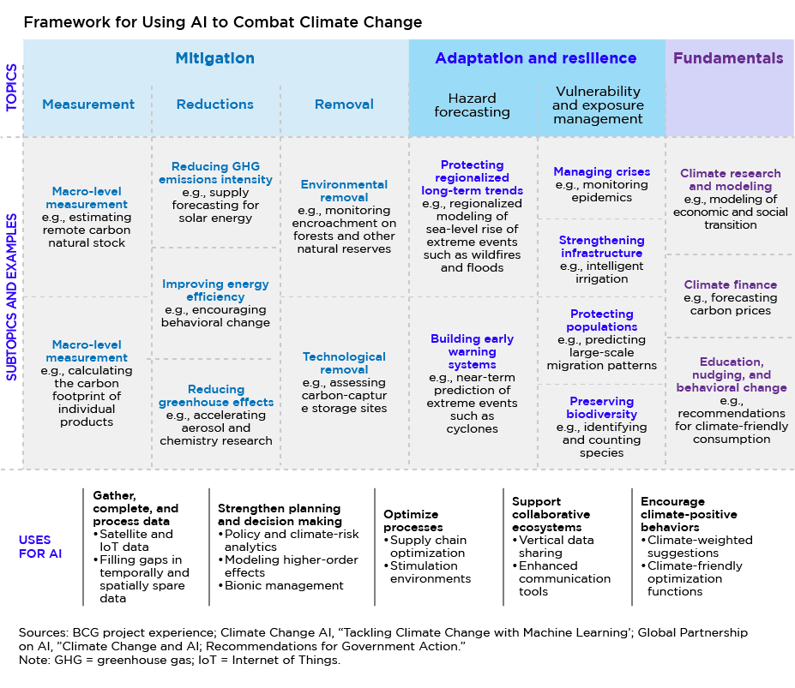
While the use cases for AI may be diverse, its value proposition largely remains the same:
- It can make models, and consequently decisions, much more data-centric;
- It can incorporate more detail and richness of the real world;
- It can improve the accuracy and granularity of predictions;
- It can lower the cost and improve the efficiency of otherwise manual workflows;
- It can self-learn and improve over time.
AI for flood predictions
Take, for example, the case of flood forecasting. Given the complicated nature of flood dynamics, floods are affected by a number of environmental factors, both in areas where the flooding occurs as well as in upstream regions. However, currently, there is a lack of region-specific datasets, which hinders the ability of traditional models to make region-specific predictions. Similarly, given the complicated nature of input data, traditional flood forecasting models generally struggle to separate relevant information from noise.
In contrast to traditional forecasting models, modern AI-powered models have shown remarkable progress in overcoming these challenges. These AI models are able to ingest data from a more diverse set of sources, including satellite images, water level gauges, and weather station readings. Moreover, these AI models rely on an attention mechanism, which imitates human visual attention, to select high-value subsets of information from a large trove of input data that are most useful for predicting floods. As a result, these models are better able to filter out useful information from noise and are better able to extrapolate learnings to regions with less availability of data. This also simplifies the process of scaling the model to various locations: rather than having bespoke models for each location, a single model can be trained to make accurate predictions for all regions.
AI for climate modelling
Historically, climate predictions have been based on Earth System Models. However, these models are extremely mathematically and computationally complex to solve, and AI is increasingly being used to tackle these problems, usually in the form of Physics-Informed Neural Networks, which have the potential to provide more accurate, interpretable models for modelling Earth systems.
The figure below shows an illustration of an Earth system where AI could be leveraged to utilize large volumes of new data coming from satellites to improve our understanding of the Earth system and improve predictions of climate-related phenomena.
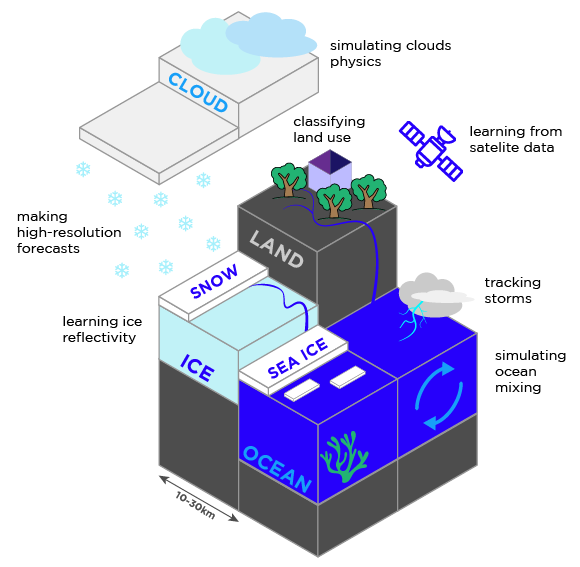
For example, recent research has shown the potential of using AI to make realistic, data-driven predictions of climate scenarios. This research uses spatial maps of historical temperatures to predict future warming potential. Not only can this approach provide more accurate estimates of when the global temperature might hit critical thresholds of 1.5 and 2 degrees Celsius, it can also provide insights into key regions that have the most impact on global temperature rise.
This approach can be extended to forecast climate scenarios at regional levels to make more localized predictions of climate change and its determinants. Such approaches could use governments and policymakers to identify the best course of action in preventing climate change.
Such an approach can also be used by corporations to simulate and forecast the financial impact of climate change on their business. For example, current scenario analyses typically rely on rigid and simplifying assumptions, where the impact of each risk is considered independently, and the economic impact of each risk factor is assumed to be linear. But such assumptions are typically flawed (e.g. see this research from psychiatry and medicine), which can lead to model risks with real consequences.
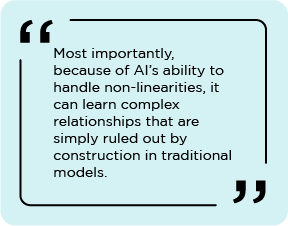 In contrast to these traditional approaches, an AI approach to scenario forecasting can use the company’s internal data, along with external climate and macro-economic factors, to learn the joint dynamics and inter-dependence of multiple risk factors. Most importantly, because of AI’s ability to handle non-linearities, it can learn complex relationships that are simply ruled out by construction in traditional models. This can allow AI models to do a much better job of predicting the collective economic impact when multiple risk factors can all evolve at the same time and may have a non-linear impact on the economic outcomes.
In contrast to these traditional approaches, an AI approach to scenario forecasting can use the company’s internal data, along with external climate and macro-economic factors, to learn the joint dynamics and inter-dependence of multiple risk factors. Most importantly, because of AI’s ability to handle non-linearities, it can learn complex relationships that are simply ruled out by construction in traditional models. This can allow AI models to do a much better job of predicting the collective economic impact when multiple risk factors can all evolve at the same time and may have a non-linear impact on the economic outcomes.
AI for sustainability advisory
Finally, given the significant progress in the language and reasoning abilities of AI models, AI models can now be used to provide companies with actionable sustainability advice targeted to the company’s business realities in a simple-to-understand language.
For example, companies typically rely on ESG consultants and stakeholder surveys to help them identify material sustainability issues, set sustainability targets for material issues, create a realistic roadmap to achieve these targets and communicate it to various stakeholders within the organization. The current process, however, can be fairly intensive in terms of manual human labour needed.
This process of identifying material issues and setting and communicating sustainability targets can be significantly improved with the aid of AI. For example, Knowledge Graphs can help a company synthesize its internal business information with external sustainability advice, prevailing regulatory requirements, best practices in the industry, and the sustainability targets of its peers.
Such a knowledge graph can then enable a company to:
- Get a real-time assessment of material issues and relevant regulations as the business evolves;
- Find industry-standard sustainability targets for companies with similar size and business activities;
- Visualize supply-chain relations to spot early warning signs of how sustainability issues in one part of the supply chain may affect the overall business;
- Centralize information in one knowledge base to facilitate efficient communication of real-time information across stakeholders.
Conclusion
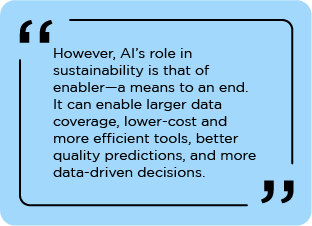
The potential for AI in supporting sustainability is strong and spans many different use cases. However, AI’s role in sustainability is that of enabler—a means to an end. It can enable larger data coverage, lower-cost and more efficient tools, better quality predictions, and more data-driven decisions. But the onerous of leveraging the enabling potential of AI, setting ambitious sustainability targets, and making the right decisions to achieve those targets rests squarely upon us.
To find out more about ESGenie - watch this video
References
2: https://time.com/6247678/openai-chatgpt-kenya-workers/
3: https://www.nature.com/articles/s41597-023-01975-w
4: https://www.sciencedirect.com/science/article/abs/pii/S0022169423001051
5: https://www.axios.com/2023/05/22/googles-ai-flood-forecast
6: https://aiforgood.itu.int/flood-forecasting-at-google-the-ai-solution-for-global-impact/
7: https://www.bcg.com/publications/2022/how-ai-can-help-climate-change
8: https://www.pnas.org/doi/10.1073/pnas.2207183120
9: https://www.nestle.com/sites/default/files/2021-04/2020-tcfd-report.pdf
11: https://ajp.psychiatryonline.org/doi/full/10.1176/appi.ajp.158.6.848
13: https://neo4j.com/blog/demystifying-environmental-social-and-governance-esg-reporting-with-graphs/


COMMENTS